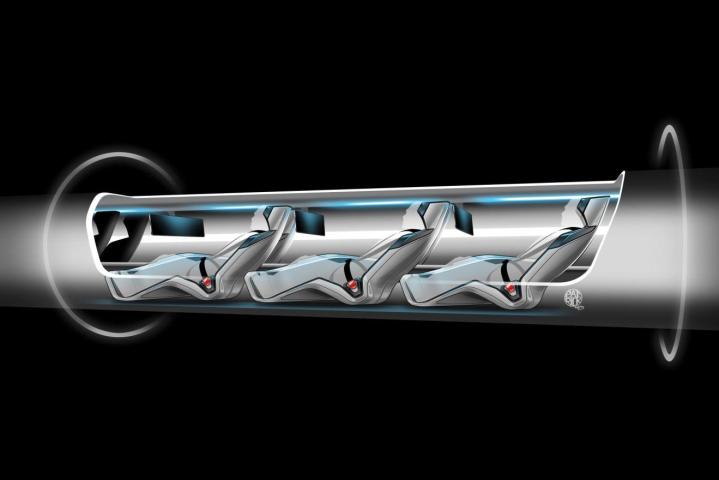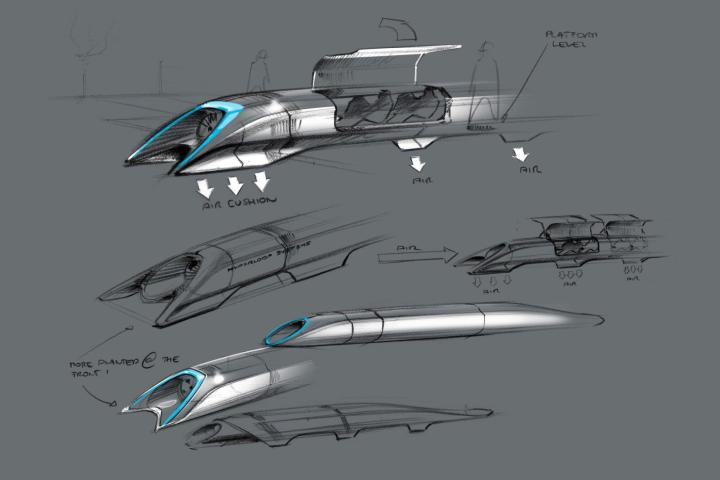
On Monday, tech wunderkind Elon Musk, founder of Tesla Motors, SpaceX and a driving force at SolarCity, released a PDF detailing his initial vision of the inner workings of the Hyperloop, a high-speed transportation system inspired by Musk’s disdain for a proposed “high-speed” train line between Los Angeles and San Francisco that would cost tens of billions of dollars and go only 115 miles per hour.
Musk estimated the system could carry 7.4 million people a year at about $20 per one-way ticket. Yes, twenty dollars.
Called “Hyperloop Alpha,” Musk envisions a “fifth mode of transportation” (after planes, trains, automobiles, and boats) that travels up to 700 miles per hour and ferries passengers between California’s two major cities – incidentally, a commute Musk makes with some frequency – in just 30 minutes. Oh, and it could cost less than one tenth of what the proposed high speed train would cost.
What it is, what it does, how it works
The Hyperloop is a (relatively) short distance high-speed transportation system consisting of a pair of enclosed tubes held above the ground on pylons. Inside, small capsules holding passengers would zip though the tubes at near the speed of sound. The tubes are joined at each end to form a “loop.”
According to the Alpha plans, most of the air would be pumped out of the tubes to decrease aerodynamic drag on the capsules but it would not operate in a vacuum, which Musk says is not practical, due to the engineering challenge of building a system completely free from any leaks at any time. Rather, Musk envisions a “low pressure” system with air pumps deployed to keep the pressure even throughout the system.
The capsules would scoot through the tubes on Linear Induction Motors, which requires some explanation. If you’ve ever pushed two magnets together and felt them push away from each other, that’s the basic principle for levitating and making the capsules move. By amping up the magnetism with electricity and laying out a long line of magnets in the track and along the bottom of the capsules, the capsules can both be levitated and pushed along by the repulsive forces.
The capsules would ride on a magnetic track with rails – not wheels – on the capsules moving in slots to keep things stable, all pushed along by a periodic boost from the repulsing magnets. due to the low drag in the system, Musk said the electromagnetic lifting system would only need to “boost” the capsules every 70 miles or so – or about once a minute.
What would it be like to ride in the Hyperloop? Musk claims it would much like riding in a modern jet on a turbulence-free flight
Even though the air pressure in the tubes would be low, the capsules would move fast enough to somewhat “fly” along the inside of the tubes, lessening the amount of power need to lift them free of contact. The route would have to be pretty direct as tight turns are not in Hyperloop’s bag of tricks. Musk said any (very, very gradual) turns would not be felt by passengers.
The track tolerances would be tight but Musk says a “combination of the capsule control system and electromagnetic centering forces allows the capsule to safely enter, stay within, and exit such a precise gap.” Because at some point, the train must slow down pull into the station.
Another interesting bit: the Hyperloop tubes would rest atop huge pylons, but would not be fixed the way a freeway overpass is bonded to its supports. That way, if an earthquake hit, their ability to squirm about as the ground shook, coupled with 3-axis motion dampeners, would make the system more earthquake-proof than traditional infrastructure.

What would it be like to ride in the Hyperloop? Musk claims it would much like riding in a modern jet on a turbulence-free flight; there would be no sensation of speed. Since the system is enclosed and elevated, the problems of weather, crossings, land use and malcontents putting things on the track are largely eliminated.
Electrical power for the seemingly sci-fi transport would come from solar panels mounted on the top of the Hyperloop’s twin tubes, although Musk said covering the entire length of the system would actually generate too much power. And at night or in poor sunlight, batteries similar to those used in his Model S electric cars could power the system and then charge up again by day.
This wouldn’t be some tubular Concorde for the well-heeled or wealthy. Musk estimated the system could carry 7.4 million people a year at about $20 per one-way ticket. Yes, twenty dollars.
Planes, Trains and Hyperloops

The plan is not without caveats. Musk said the Hyperloop system is a better fit for shorter distances of 900 miles or less because supersonic transport aircraft would be more economical and faster over longer distances and of course, would not require an infrastructure of tubes. Presumably he’ll be making that available to the masses as soon as he’s done with Tesla.
Musk said the ideal route for the Hyperloop would be along the relatively straight Interstate 5 corridor through California’s San Juaquin Valley down to Los Angeles. The pylons would be 100 feet high – or about eight-to-10 stories – which makes it likely that someone somewhere along the route would complain about the Hyperloop mucking up their view.
But Musk says any inconveniences of the Hyperloop pale in comparison to a “traditional” high-speed rail line which is subject to weather, is noisy, and takes up huge swaths of land. And, of course, there’s the massive cost of laying down not-even-best-in-class bullet train tracks, which partly got this Hyperloop feedback loop started.
Do I hear $6 billion?
Musk rails at the proposed price of the rail line, which he estimated would actually top $100 billion before completion and would essentially be out of date on arrival – if not before construction – and still fail to trump air travel in terms of cost or convenience. He estimates the SF to LA Hyperloop would cost $6 billion to complete. Even at twice that figure, it would be a bargain and a technical marvel that could lap (literally) the fastest existing trains in the world, which can’t even sniff at 400 mph.
Musk says he wants the Hyperloop to be open-source so other smart people can improve it and add new ideas. In a press conference Monday, he essentially said he wants someone else to build it because, basically, he’s too busy now with Tesla and SpaceX. But the longer he talked about the project, the more he appeared to talk himself into being involved. “I’m tempted to at least make a demonstration prototype,” he said, before adding that he could be involved with the initial phases of the project. “I think I’ll probably end up doing that.”
Successfully building the Hyperloop on any scale near what Musk is proposing would leapfrog every other high-speed transportation system in the world and he claims it could be done in seven to 10 years time.
What do you think of the Hyperloop idea? Tell us in comments.






